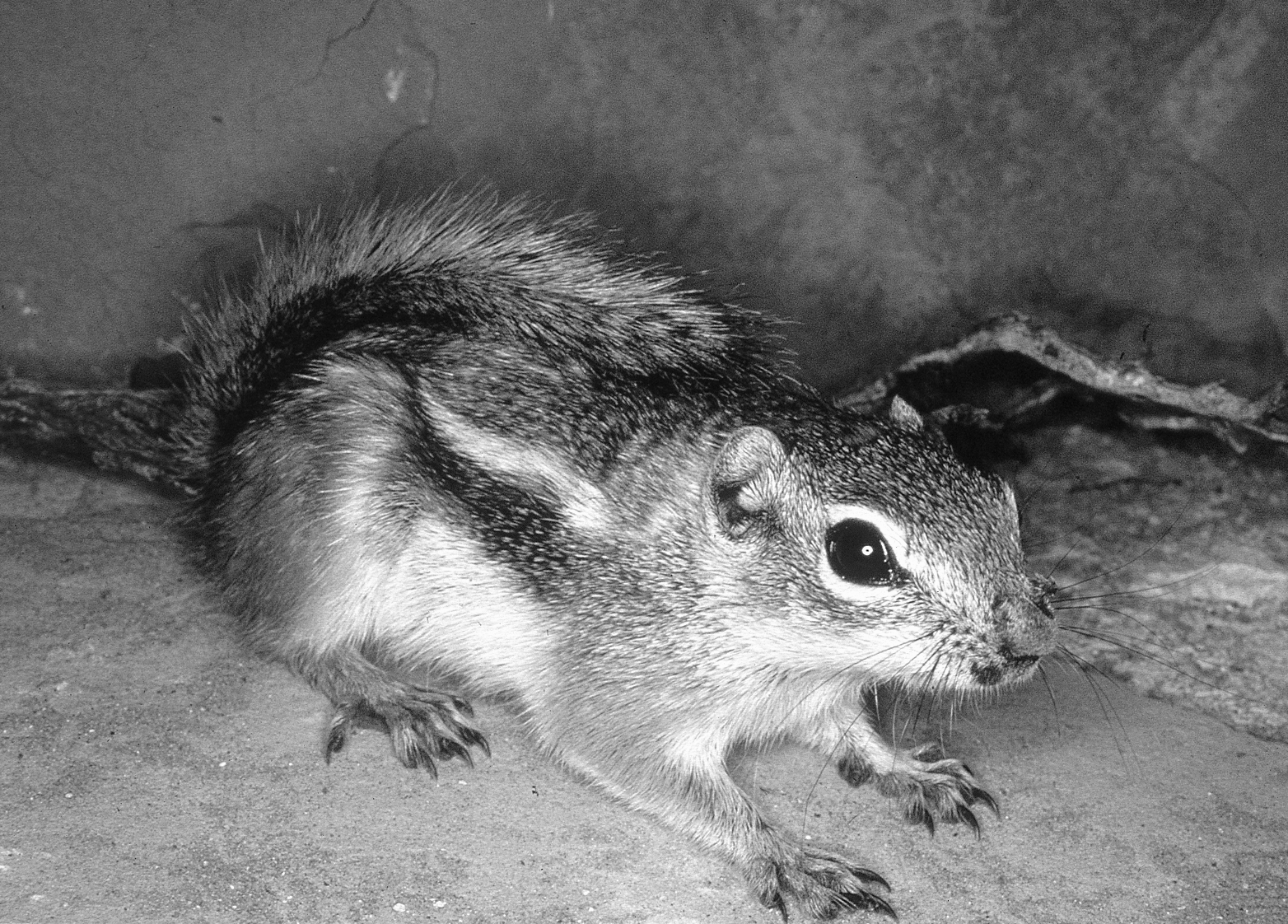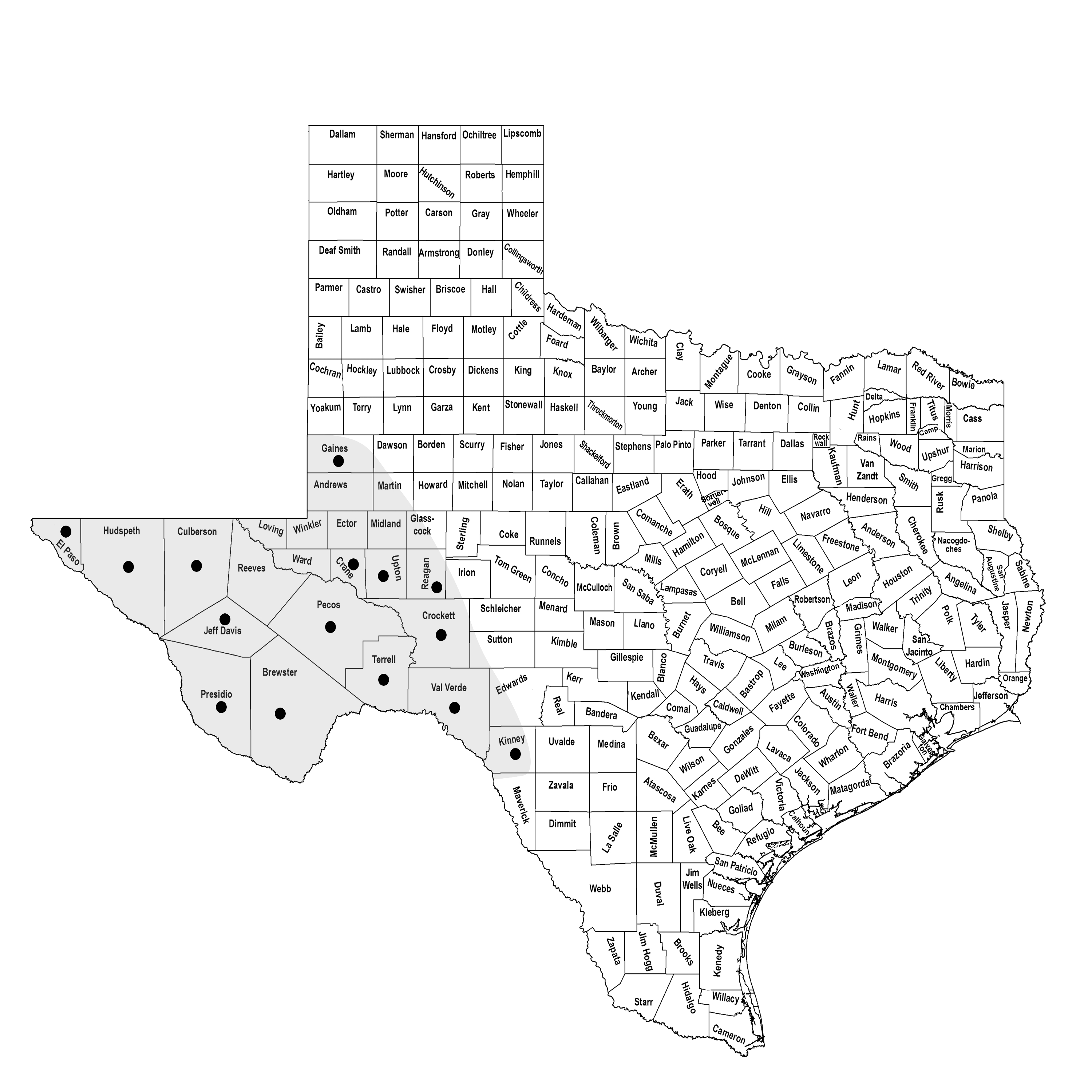TEXAS ANTELOPE SQUIRREL
Ammospermophilus interpres (Merriam 1890)
Order Rodentia : Family Sciuridae
DESCRIPTION. A small ground squirrel with one narrow white line on each side of back from shoulder to rump and underside of tail grayish white, the lateral tail hairs with three black bands; upperparts vinaceous buff in summer and drab gray in winter; ears short, hardly more than a rim; tail held over back. Dental formula: I 1/1, C 0/0, Pm 2/1, M 3/3 × 2 = 22. Averages for external measurements: total length, 226 mm; tail, 74 mm; hind foot, 38 mm. Weight of males, 104 (94–121) g; of females, 104 (84–115) g.

DISTRIBUTION. Known throughout the Trans-Pecos region (and not just adjacent to the drainages of the Rio Grande and the Pecos River), extending eastward to the extreme western portion of the Edwards Plateau, where specimens have been reported from Crane, Crockett, Reagan, Upton, Kinney, and Val Verde counties, and northward to the southern edge of the High Plains in Gaines County.

SUBSPECIES. Monotypic species.
HABITS. These squirrels are characteristic of desert regions in the Southwest, where they live primarily around the edges of the lower valleys and in the low hills. They seem to prefer hard-surfaced, gravelly washes or rocky hill slopes and are less common or entirely absent on level, sandy terrain. On the Edwards Plateau, they seem to be limited to rocky, broken terrain with little ground cover. In this area, they are often associated with creosote and juniper vegetation.
They usually live in burrows, but crevices in and among rocks may serve as den sites. Their burrows usually are situated at the side of a clump of bushes, a boulder, or in a cut bank. There usually is no mound of earth to mark the entrance. One burrow found in a cut bank was excavated in friable soil under a bed of hardpan about 1 m below the top of the ground and 50 cm above the roadbed. The main tunnel was 8.7 cm in diameter, 3 m long, and lay parallel to and about 30 cm back from the face of the cut. Access was by three openings. Midway in the tunnel was the nest chamber, which measured 12.5 cm in width, 17.5 cm in length, and 10 cm in height. An accessory loop in back of the nest and two blind pockets at one end of the main tunnel completed the system. The nest was composed of rabbit fur, shredded bark, feathers, dried grasses, and bits of cotton.
"Ammos" are fidgety, nervous creatures and seldom are still. They are nimble footed and can run with surprising speed; they are well adapted for climbing. Their peculiar habit of carrying the tail arched forward over the back, exposing to view the contrastingly colored undersurface, is a readily usable field characteristic. The nervous flicking of the tail when the animals are excited and the mellow, rolling, trill-like calls further assist in identification. They spend most of the time on the ground, but they may be seen in the tops of low bushes, yuccas, and prickly pears, where they also forage. Available evidence indicates that at lower elevations these ground squirrels do not hibernate.
Antelope ground squirrels are one of the few mammals that may remain active during the hottest parts of West Texas summers. Occasionally they retreat to a shady spot where they lie outstretched, with their limbs spread-eagle and their belly in contact with the cooler terrain; thus excess heat accumulated during their activities is rapidly lost and the squirrels are able to maintain a safe body temperature. After such rests, the squirrels return to normal activities until overheating again. Their food is largely a wide variety of plant materials, including the fruits, seeds, and stems of yucca, juniper, salt grass, prickly pear and cholla cactus, mesquite, sotol, and creosote bush, but insects may be consumed when available.
Breeding begins in February. One litter of 5–14 young, based on embryo counts, is reared each year, but there is evidence that some females may rear a second brood. The young remain in the nest until they are about one-fourth grown, at which time they venture aboveground and begin eating solid foods. Information on other phases of reproduction is lacking.
POPULATION STATUS. Uncommon. Although infrequently encountered, the Texas antelope squirrel is widely distributed in western Texas.
CONSERVATION STATUS. The IUCN lists the Texas antelope squirrel as a species of least concern, and it does not appear on the federal or state lists of concerned species. There does not appear to be any immediate threat to its status.
From The Mammals of Texas, Seventh Edition by David J. Schmidly and Robert D. Bradley, copyright © 1994, 2004, 2016. Courtesy of the University of Texas Press.
Natural Science Research Laboratory
-
Address
Museum of Texas Tech University, 3301 4th street, Lubbock, TX 79409 -
Phone
806.742.2486 -
Email
nsrl.museum@ttu.edu

